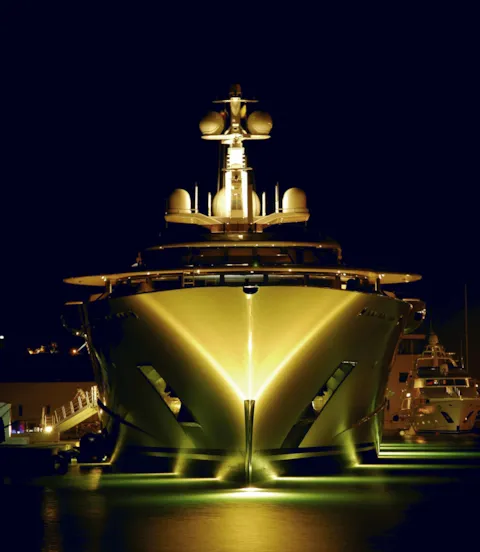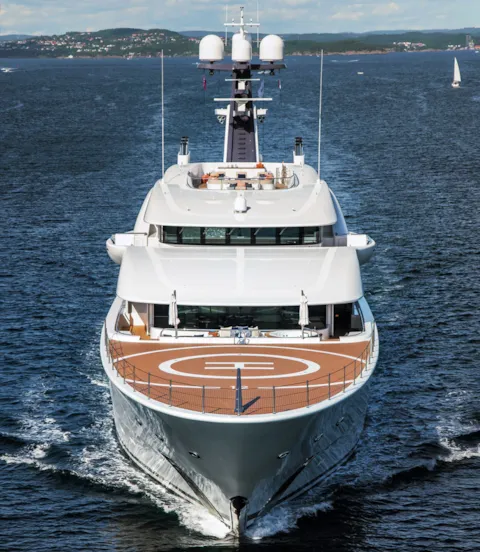Individuality and excellence
Customer satisfaction is a top priority for builders of high-end yachts. Fulfilling the owner’s special wishes while complying with strict rules and regulations is part of day-to-day business for the luxury yacht specialist Fr. Lürssen Werft, Bremen, and their cooperation partners, the experts from DNV GL.
Just a few weeks ago Dr Justus Reinke took his two small children along on a visit aboard a yacht. “The biggest fascination was the lifeboats,” the proud father retells. Even those were probably generously sized: Reinke is the executive in charge of yachts at the Bremen-based shipbuilding company Fr. Lürssen, a company with a long tradition that specializes in luxury craft – super and mega yachts for the most demanding clients.
An economics expert with a PhD, Reinke is responsible for all market and customer-facing activities at Lürssen, including sales and marketing, technical project planning, contracting, as well as re-fitting, interior outfitting and guarantee management. “In our project management team we take a holistic approach,” explains Reinke. While CEO Peter Lürssen, the great-grandson of the company’s founder, is usually the “face to the customer”, there are various subject-matter experts available when a specific detail needs to be discussed. Sometimes the Lürssen staff will directly interact with well-to-do customers, some of whom get deeply involved with their projects and drop by the yard regularly to see how things are going, especially experienced yacht owners who have built yachts before. Others prefer to stay in the background, relying fully on their owner’s technical representative. “It is a different situation every time, and that’s what makes this work so unique,” says Reinke.
What about the mega yacht market? “You can’t really call it a market. The relevant demand decreases as yachts get bigger,” explains Reinke. Mega yachts are not a repeating business. On average, the yard delivers about three large yachts per year. ‘Bigger’ is not necessarily better, he points out: “We start with a length of about 55 metres, that is the range where we feel at home.” Yachts up to roughly 100 metres in length are built by the company’s facility Lürssen-Kröger Werft near Rendsburg, whereas the largest ones are created at the Bremen main yard.

Each vessel is unique
Whether you take the 85-metre yacht Areti or the 123-metre Al Lusail, both of which were delivered last year and are DNV GL classed, every ship built by Lürssen is one of a kind. That makes things especially challenging for the yard team. “We only get one try and everything has to be perfect. That requires impeccable processes and extremely diligent people.” Projects are getting more and more complex: special customer requests, unusual design ideas, innovative technical solutions and applicable regulations all have to be reconciled so the future owner will be fully satisfied when the ship is finished. “This is why we begin cooperating with classification societies such as DNV GL at a very early time so that any potential issues can be resolved immediately,” says Reinke. The classification experts have comprehensive know-how and can provide recommendations on how to optimize a design or its implementation.
Right now, Lürssen is collaborating with DNV GL on several projects. “We need to work with people who understand our business; people who know that standardized solutions are not what we need.
In our business, being able to cater to individualism is what counts,” Reinke stresses. When well-known, highly experienced designers such as Espen Øino or Tim Heywood are involved, they want to give their yachts a unique touch. That includes innovative hull forms and design features that push the limits.
“In many cases this means we as a classification society have to get creative,” Dirk Lange confirms. As a Key Account Manager at DNV GL – Maritime, the shipbuilding engineer is used to working closely with the Lürssen team. Meeting stringent aesthetic expectations without compromising safety is an art, he says. One of the current trends he tries to accommodate is generous glasswork around the bridge. “The classification society does have some room for interpretation in this respect, but whatever it does it has to defend vis-à-vis the flag state administration,” says Lange. Quite often these designs require additional calculations or tests.

Rules provide the framework
Basically, Lürssen manager Reinke says, he is glad there is a sophisticated regulatory framework which applies to all market stakeholders and is developed continuously: “These are key guidelines that serve as a basis for our conversations with designers and customers,” he says. The topic of his doctoral dissertation was electro-mobility: “Alternative propulsion technologies and complex systems are an important field of activity for us at Lürssen,” says Reinke. The construction process is highly complex and involves numerous suppliers, in spite of the company’s considerable in-house production depth.
When the 180-metre yacht Azzam, to this day the world’s longest privately owned superyacht, was completed five years ago, Peter Lürssen said: “This vessel represents a major milestone, not only in the history of our company but in yacht building in general, as well.”
There are many more milestones: “Doing something for the very first time is always the biggest challenge,” says Reinke, no matter whether it is a complex pool, a spa landscape with a cold chamber, or a sophisticated digital entertainment system.
Similar to other shipbuilding segments, high-end yacht design is highly dependent on general trends in the shipping industry, as the recent SMM trade fair in Hamburg showed once again. Apart from digitalization, sustainability is high on the current agenda. Since the clientele in this segment is exceptionally demanding, the solutions developed here are often leading edge. For example, all Lürssen-built vessels adhere to IMO’s strict Tier III criteria for nitrous oxide emissions, and alternative propulsion systems are frequently discussed, as well: “Environmental awareness is quite strong among our customers. They take responsibility, and at the same time they are highly interested in clean oceans, which is part of the yachting experience.” From diesel and diesel-electric systems to the increasing interest in battery banks to back up the on-board electricity grid, there is a wide range of options. Even liquefied natural gas (LNG) is being considered (see page 22). But Reinke is somewhat sceptical because of the patchy bunkering infrastructure. “Being able to travel wherever you want is an important aspect of yachting, and when you depend on LNG, that simply isn’t possible yet.”
Trust and expert guidance are definitely two criteria that are of utmost importance for the business success of Lürssen: the company owes its excellent reputation to its experience completing sophisticated projects that have earned it the trust of its customers. “The fact that we are a family-owned business is extremely important. Unlike a public company, we do not have to present specific quarterly results or answer to any third parties. We can calmly make our own decisions in a flat hierarchy,” says Friedrich Lürssen, Managing Partner of the Lürssen Group and Peter’s cousin.

Full service package
Engineering Made in Germany is another important criterion that appeals to customers. Whether in engineering or production, Lürssen exclusively employs highly qualified staff. In addition, the shipbuilder will provide holistic assistance to the owner, if so desired: the company’s “Yacht Management” service package includes training, crew management and other services such as housing, obtaining visas and organizing port stays. Custom maintenance, repair or refitting services keep yachts ‘state-of-the-art’ throughout their lifetime, often with the help of the specialists of the Hamburg-based Lürssen subsidiary Blohm+Voss.
Apart from superyachts, naval vessels are Lürssen’s second major line of business. Both can profit from each other to a certain degree: “Both involve enormously complex systems, and some aspects are relevant to both ship types,” explains Reinke. As an example he mentions the issue of noise emissions: “Yacht customers want to enjoy comfort and calm, and for naval vessels quiet operation is crucial for security reasons.”
Sheiks, billionaires, superstars? There are all kinds of rumours and legends surrounding Lürssen’s customers, but the company has a tradition of keeping its lips sealed in this respect. All they are willing to say is this: the main cruising regions for yachts continue to be the Mediterranean and the Caribbean. After all, the special flair and infrastructure of specific ports is part of the yachting experience, and other parts of the world, such as some Asian regions, have not developed these capabilities as yet. There might be a future market there. A conspicuous trend among owners is their increasing appetite for adventure. As a consequence, special properties such as ice class are beginning to play a more important role. The yard has already delivered a few high-tech expedition yachts.

True craftsmanship
“What triggers my enthusiasm time and time again is the love for detail and a perfect finish,” says Reinke. Segment-specific rules and standards, such as the Red Ensign Group’s Passenger Yacht Code (PYC), require utmost attention to detail regarding the materi als used for the ship’s interior, including flammability and other aspects. Some surfaces must be covered with paper-thin layers of genuine wood, which involves tedious manual work. “What our suppliers from Germany and Austria accomplish is true craftsmanship,” says Reinke. The enthusiasm of yacht building is obviously still very much alive in this company even after generations.

